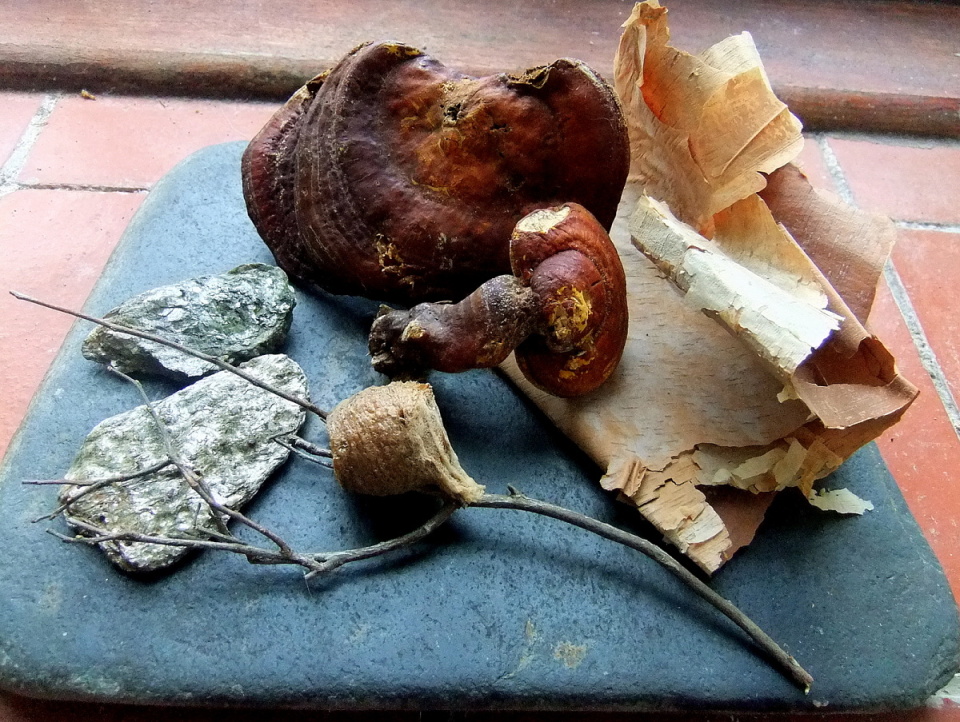Transatlantic trophies
The weather in West Wales today has been one long deluge. Raindrops were hammering on the roof, the dog never stirred from his beanbag and even the ducks were complaining. I was forced to undertake the indoor tasks that I usually ignore, just for the sake of some activity. I opened a heap of unopened correspondence and then tackled a pile of items that I'd unloaded when I returned from America almost a month ago. That was how I came upon this little collection of souvenirs. I can't believe I had forgotten about them because they were the most interesting things I had found, along with the muskrat skull I blipped before.
Here they are:
1. At the back, two specimens of Ganoderma lucidum, the varnish fungus, which I found growing on a hemlock in the Quaker burial ground in Philadelphia. This mushroom, known as lingzhi in China and reishi in Japan, is the most highly venerated fungus in Eastern medicine, and has been used therapeutically for over 2000 years. It's regarded as the ultimate herbal substance, a virtual panacea, held to confer good fortune, longevity and even immortality as well to as to treat a wide range of illnesses. It's cultivated extensively to meet high demand in China. Modern research has shown the fungus to have anti-bacterial and anti-viral properties, to inhibit cancer cells, protect the liver and boost the immune system.
2. Right, some bark from the paper birch Betula papyrifera that I found in the garden of the excellent museum at Reading PA. Birch bark was used extensively by the indigenous North Americans to make canoes and wigwams, and all over Scandinavia, Russia and Siberia to make boxes and buckets, clothes and shoes, and as parchment for writing. In the ancient Russian city of Novgorod birch bark documents have been found preserved by the acid soil in layers that go down to the mediaeval period. They include business notes, love letters, household bills, children's drawings and lessons, all dating back to the 1400s. More recently, political prisoners in the gulags used birch bark to try to communicate with their families.
3. In the centre is a peculiar sort of cocoon attached to a twig. I can't recall where I found it, probably in a cemetery - I was in a hurry and just snapped it off and forgot about it. Today I was amazed to discover, with the help of Google images, that it's the egg case of a praying mantis. "Eggs are typically deposited in a frothy mass that is produced by glands in the abdomen. This froth then hardens, creating a protective capsule with a further protective coat, and the egg mass is called an ootheca." It may produce 30 to 300 young mantids depending on the species! I'm so excited to think that if the eggs have survived the transatlantic flight I could have a brood of baby mantises come the spring. (Will they still be jet-lagged?)
4. Finally, on the left, two pieces of schist that I picked up near the Wissahickon Creek in Philadelphia. It's the principle bedrock of the area and many of the city's old houses are built of it. It contains specks of mica which glitter and sparkle in the sunshine, something I have found quite captivating in my visits to the city although the residents seem to take it for granted. The name schist (which you have to say quite carefully) comes from the Greek word for 'to split', on account of it being a sedimentary rock which, like slate and shale, separates into layers.
So, I have ended up with something to cure me, something to write on, something that may produce a big family and some bits of the North American continent. And none of it from the duty-free shop. I feel so fortunate!


Comments
Sign in or get an account to comment.


